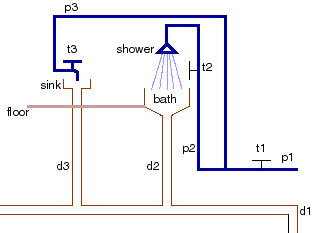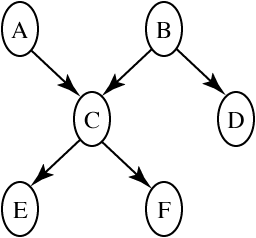CPSC 502 -- Fall 2006
Assignment 4
Due: 12:30pm, Monday 30 October 2006.
Consider the domain of house plumbing represented
below.
This is a simplified model of the same domain used in the previous assignment.
In this figure, p1, p2 and p3 denote cold water
pipes. p1 is the pipe coming in from the main water
supply. t1, t2 and t3 are taps and d1, d2 and
d3 are drainage pipes. The constants shower denotes a shower,
bath denotes a bath, sink denotes a sink, and floor denotes the
floor. There can also be plugs in the sink or in the bath. You can
assume that you are in a static situation (i.e., you don't have to
worry about time); imagine that you have stumbled in this situation
and must reason about it.
Suppose you can observe or query the tap positions, flow out of drain d1, and
whether there is water in the sink and bath, and whether there is
water on the floor.
 plumbing.gif
plumbing.gif
The Plumbing Domain
- What are the random variables? In particular, you need random
variables to represent the observations you may want to make, the
queries you may be interested and other (hidden) variables to keep
the model simple. For each variable, give its domain and intended
interpretation.
- Give a belief network for these variables, assuming a causal
ordering of the variables. Give reasonable conditional probability
tables. You can use the CIspace applet or any other belief network
tool.
(e.g., Netica or
Genie).
- Suppose you had to demonstrate to a skeptic that Belief networks
are appropriate for this domain. Argue that this is a reasonable
representation, and as part of your explanation, you need to give
some test cases that show what your model is capable of. Use proper
English. Be brief and concise (as this skeptic doesn't have much
time).
- What would your belief network look like if you had chosen the
opposite ordering of variables?
Consider the belief network:
 abcdef.gif
abcdef.gif
|
P(a) | = | 0.9 |
|
P(b) | = | 0.2 |
|
P(c|a,b) | = | 0.1 |
|
P(c|a,¬b) | = | 0.8 |
|
P(c|¬a,b) | = | 0.7 |
|
P(c|¬a,¬b) | = | 0.4
P(d| b) | = | 0.1 |
|
P(d|¬b) | = | 0.8 |
|
P(e|c) | = | 0.7 |
|
P(e|¬c) | = | 0.2 |
|
P(f|c) | = | 0.2 |
|
P(f|¬c) | = | 0.9
|
- Compute P(e) using variable elimination. Please try to do it
by hand, then check it with the CIspace applet. Do not do any
pruning. Explain the significance of each factor created (either what does it
represent or why does it have particular values).
- Compute P(e|¬f) using variable elimination. How much of
the previous computation can be reused? Show only what is different.
- Compute P(a|d) using variable elimination.
- Compute P(a | ¬f).
- Compute P(a|¬f,d).
- Explain when observing d affects your belief in a. (Be as
specific as possible.)
Suppose you want to compute P(f|d) in the belief network of the
previous question. You are to use this example to explain how each of
the following work. (Assume you are writing a textbook for your peers,
and are using this example to explain these concepts)
- Rejection sampling
- Importance sampling
- Particle filtering
David Poole
 plumbing.gif
plumbing.gif
 plumbing.gif
plumbing.gif
 abcdef.gif
abcdef.gif